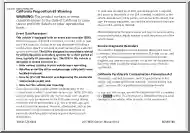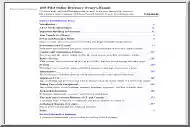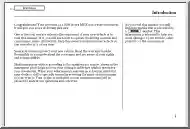No comments yet. You can be the first!
Content extract
Source: http://www.doksinet Dean’s Corner Jonathan I. Ravdin, MD Local response to infectious diseases facilitated by resources and preparedness Jonathan I. Ravdin, MD Dean and Executive Vice President, Medical College of Wisconsin T he ability to effectively respond to a biological crisis hinges on successfully identifying the threat. While the World Health Organization was declaring the first influenza pandemic in 41 years, the Medical College of Wisconsin (Medical College) was developing tools to differentiate and diagnose the flu subtypes of patients in Milwaukee, which last year experienced 1 of the largest outbreaks of novel swine origin influenza virus (SOIV) in the country. This outbreak of novel influenza A (H1N1) virus occurred in late April 2009, and the Medical College’s Midwest Respiratory Virus Program (MRVP) responded with multiple assays and already developed, state-of-the-art technology newly created by Kelly J. Henrickson, MD, Professor of Pediatrics and
Microbiology at the Medical College, and the Respiratory Virus Program team. One of these (FluPlex, a rapid multiplex, reverse transcription polymerase chain reaction enzyme hybridization assay) can simultaneously detect and distinguish between influenza A and B viruses and identify all influenza A virus subtypes that have infected humans. It additionally is able to delineate the human and animal variants. The test was used to confirm the diagnoses of the first patients in Wisconsin infected with the 2009 H1N1. In just the first 2 weeks of the Milwaukee outbreak, FluPlex correctly identified 206 clinical samples as positive or negative and correctly typed and subtyped viruses from the positive samples. Importantly, its accuracy was confirmed when results were compared with assays validated by the Centers for Disease Control and Prevention (CDC) and approved by the Food and Drug Administration (FDA). Rapid and accurate detection is critical for initiating the appropriate public health
response to emerging infectious diseases. With knowledge of H1N1 limited at the time of outbreak, the fast, effective and inexpensive tests developed by the MRVP allowed health care professionals at Froedtert Hospital and Children’s Hospital of Wisconsin, and eventually elsewhere in the state, to better manage their patients and limit the virus’s transmission. Swift local surveillance is a key component to curbing an outbreak and potentially preventing an infectious disease from reaching epidemic or pandemic levels. Although the H1N1 virus became pandemic, efforts to quickly diag- nose and treat infected patients likely decreased morbidity and mortality rates. The latest efforts in Dr Henrickson’s lab have been directed at automating the FluPlex test, which has met with initial success. This example of ongoing innovation demonstrates an academic medical center’s ability to develop resources that benefit medicine and protect the public’s well-being. We regard that ability as
a responsibility, which is why the Medical College also supports a research resource whose programs focus on defense against infectious diseases. The College’s Center for Biopreparedness and Infectious Diseases (Center) was established in 2003 and continues to meet the need for developing diagnostics, therapies and vaccines to combat select agents and chronic and emerging infectious diseases. Directed by Dara Frank, PhD, Professor of Microbiology and Molecular Genetics, the Center emphasizes threats considered especially problematic for the future of Wisconsin and the nation. Core faculty are engaged in research to address the mounting challenge of antibiotic resistance, to understand the mechanisms that enable bacterial survival Wisconsin Medical Journal • 2010 • Volume 109, No. 3 161 Source: http://www.doksinet and proliferation in tuberculosis infection, to prevent hospital infections including ventilatorassociated pneumonia, and to develop a successful vaccine for Lyme
disease. Our efforts encompass global health, including novel research focused on design and testing of a vaccine to protect at-risk international populations from amebiasis. Research in the Center is translational and patient-focused. In many cases, it is informed by clinical knowledge. Center investigators are building strong relationships with infectious disease clinicians, which keeps research on task with public needs and keyed in to new observations. A clinician’s window to the public is essential for timely infectious disease response. In the last few years, it was community physicians who alerted researchers when methicillinresistant Staphylococcus aureus (MRSA) began appearing in the general population, rather than remaining limited to hospitalized patients with compromised immune systems, for example. These reports created research opportunities to determine what changes allowed the organism to enter the community. Such interactions form the essence of a local response
network, the fundamental basis of which can be successful on a much larger scale. The Center is part of the Region V Great Lakes Regional Center of Excellence. Psychiatrist Amery, Wisconsin HealthPartners has an exciting opportunity for a practicing psychiatrist to join our group at the Amery Regional Medical Center (ARMC) in Amery, WI. This key position will provide direct patient care as chief physician for our psychiatric treatment program, coordinate ARMC’s psychiatric medical policies and procedures, and implement appropriate integration of clinical and medical services. Top candidates will be board certified by the American Board of Psychiatry and Neurology or the Osteopathic Board of Neurology and Psychiatry. Geriatrics experience or board eligibility in geropsychiatry is preferred. Forward CV and cover letter to lori.mfake@healthpartnerscom or apply online at www.healthpartnersjobs For more details, call (800) 472-4695 x1. EOE w w w.hea lt hpa r t ner scom 2010 NAS
(Media: delete copyright notice) In this role, the Medical College pledges to grant access to our facilities in the event of a regional biological threat. If activated, the Center could arrange laboratory space, provide and run high containment labs, and interface with local or national agencies. We may securely store samples, as we have previously done, or even offer direct assistance for select bioagents and diseases in which our faculty have special expertise. Our Center is reaching critical mass, and through informed research, coordination with clinical peers, and scientific innovation, we are poised to grow as a critical defense mechanism for the public against biological threats both natural and malicious. Family Medicine – with or without OB Osceola, Wisconsin HealthPartners Medical Group is seeking exceptional Family Medicine with or without OB physicians to join our group at Osceola Medical Center. Located along the scenic St. Croix River, Osceola is a rural Wisconsin gem
located just 45 minutes from the Twin Cities. We are currently recruiting BC/BE full-range Family Medicine with or without OB physicians to join our growing practice. Emergency Room coverage is provided Our Osceola group moved to a brand new medical center in the fall of 2008. Osceola Medical Center is part of the HealthPartners Medical Group our physicians enjoy the excellent compensation and benefits package, medical malpractice coverage and security offered by a large group, while practicing in a traditional community-based setting. For more information, contact diane.mcollins@healthpartnerscom, or call (800) 472-4695, ext 3 Apply online at www.healthpartnersjobs Job ID# 8975 Site is not eligible for visa waivers. EOE w w w. h e a l t h p a r t n e r s c o m 2010 NAS (Media: delete copyright notice) Wisconsin Medical Journal WI Medical Journal 3-1/4” x 4-1/2” 3.25” x 475” Wisconsin Medical Journal • 2010 • Volume 109, No. 3 162 B&W B&W
Microbiology at the Medical College, and the Respiratory Virus Program team. One of these (FluPlex, a rapid multiplex, reverse transcription polymerase chain reaction enzyme hybridization assay) can simultaneously detect and distinguish between influenza A and B viruses and identify all influenza A virus subtypes that have infected humans. It additionally is able to delineate the human and animal variants. The test was used to confirm the diagnoses of the first patients in Wisconsin infected with the 2009 H1N1. In just the first 2 weeks of the Milwaukee outbreak, FluPlex correctly identified 206 clinical samples as positive or negative and correctly typed and subtyped viruses from the positive samples. Importantly, its accuracy was confirmed when results were compared with assays validated by the Centers for Disease Control and Prevention (CDC) and approved by the Food and Drug Administration (FDA). Rapid and accurate detection is critical for initiating the appropriate public health
response to emerging infectious diseases. With knowledge of H1N1 limited at the time of outbreak, the fast, effective and inexpensive tests developed by the MRVP allowed health care professionals at Froedtert Hospital and Children’s Hospital of Wisconsin, and eventually elsewhere in the state, to better manage their patients and limit the virus’s transmission. Swift local surveillance is a key component to curbing an outbreak and potentially preventing an infectious disease from reaching epidemic or pandemic levels. Although the H1N1 virus became pandemic, efforts to quickly diag- nose and treat infected patients likely decreased morbidity and mortality rates. The latest efforts in Dr Henrickson’s lab have been directed at automating the FluPlex test, which has met with initial success. This example of ongoing innovation demonstrates an academic medical center’s ability to develop resources that benefit medicine and protect the public’s well-being. We regard that ability as
a responsibility, which is why the Medical College also supports a research resource whose programs focus on defense against infectious diseases. The College’s Center for Biopreparedness and Infectious Diseases (Center) was established in 2003 and continues to meet the need for developing diagnostics, therapies and vaccines to combat select agents and chronic and emerging infectious diseases. Directed by Dara Frank, PhD, Professor of Microbiology and Molecular Genetics, the Center emphasizes threats considered especially problematic for the future of Wisconsin and the nation. Core faculty are engaged in research to address the mounting challenge of antibiotic resistance, to understand the mechanisms that enable bacterial survival Wisconsin Medical Journal • 2010 • Volume 109, No. 3 161 Source: http://www.doksinet and proliferation in tuberculosis infection, to prevent hospital infections including ventilatorassociated pneumonia, and to develop a successful vaccine for Lyme
disease. Our efforts encompass global health, including novel research focused on design and testing of a vaccine to protect at-risk international populations from amebiasis. Research in the Center is translational and patient-focused. In many cases, it is informed by clinical knowledge. Center investigators are building strong relationships with infectious disease clinicians, which keeps research on task with public needs and keyed in to new observations. A clinician’s window to the public is essential for timely infectious disease response. In the last few years, it was community physicians who alerted researchers when methicillinresistant Staphylococcus aureus (MRSA) began appearing in the general population, rather than remaining limited to hospitalized patients with compromised immune systems, for example. These reports created research opportunities to determine what changes allowed the organism to enter the community. Such interactions form the essence of a local response
network, the fundamental basis of which can be successful on a much larger scale. The Center is part of the Region V Great Lakes Regional Center of Excellence. Psychiatrist Amery, Wisconsin HealthPartners has an exciting opportunity for a practicing psychiatrist to join our group at the Amery Regional Medical Center (ARMC) in Amery, WI. This key position will provide direct patient care as chief physician for our psychiatric treatment program, coordinate ARMC’s psychiatric medical policies and procedures, and implement appropriate integration of clinical and medical services. Top candidates will be board certified by the American Board of Psychiatry and Neurology or the Osteopathic Board of Neurology and Psychiatry. Geriatrics experience or board eligibility in geropsychiatry is preferred. Forward CV and cover letter to lori.mfake@healthpartnerscom or apply online at www.healthpartnersjobs For more details, call (800) 472-4695 x1. EOE w w w.hea lt hpa r t ner scom 2010 NAS
(Media: delete copyright notice) In this role, the Medical College pledges to grant access to our facilities in the event of a regional biological threat. If activated, the Center could arrange laboratory space, provide and run high containment labs, and interface with local or national agencies. We may securely store samples, as we have previously done, or even offer direct assistance for select bioagents and diseases in which our faculty have special expertise. Our Center is reaching critical mass, and through informed research, coordination with clinical peers, and scientific innovation, we are poised to grow as a critical defense mechanism for the public against biological threats both natural and malicious. Family Medicine – with or without OB Osceola, Wisconsin HealthPartners Medical Group is seeking exceptional Family Medicine with or without OB physicians to join our group at Osceola Medical Center. Located along the scenic St. Croix River, Osceola is a rural Wisconsin gem
located just 45 minutes from the Twin Cities. We are currently recruiting BC/BE full-range Family Medicine with or without OB physicians to join our growing practice. Emergency Room coverage is provided Our Osceola group moved to a brand new medical center in the fall of 2008. Osceola Medical Center is part of the HealthPartners Medical Group our physicians enjoy the excellent compensation and benefits package, medical malpractice coverage and security offered by a large group, while practicing in a traditional community-based setting. For more information, contact diane.mcollins@healthpartnerscom, or call (800) 472-4695, ext 3 Apply online at www.healthpartnersjobs Job ID# 8975 Site is not eligible for visa waivers. EOE w w w. h e a l t h p a r t n e r s c o m 2010 NAS (Media: delete copyright notice) Wisconsin Medical Journal WI Medical Journal 3-1/4” x 4-1/2” 3.25” x 475” Wisconsin Medical Journal • 2010 • Volume 109, No. 3 162 B&W B&W




 When reading, most of us just let a story wash over us, getting lost in the world of the book rather than paying attention to the individual elements of the plot or writing. However, in English class, our teachers ask us to look at the mechanics of the writing.
When reading, most of us just let a story wash over us, getting lost in the world of the book rather than paying attention to the individual elements of the plot or writing. However, in English class, our teachers ask us to look at the mechanics of the writing.